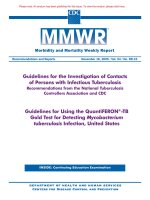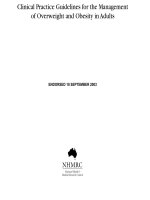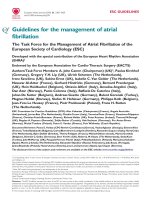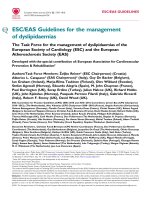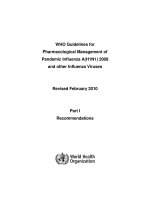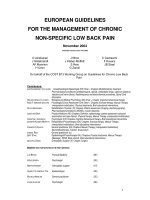Guidelines for the Management of Lower Respiratory Tract Infection (LRTI) and Hospital Acquired Pneumonia in Adults
Bạn đang xem bản rút gọn của tài liệu. Xem và tải ngay bản đầy đủ của tài liệu tại đây (79.87 KB, 8 trang )
Guidelines for the Management of Lower Respiratory Tract Infection (LRTI) and
Hospital Acquired Pneumonia in Adults
Version
Date ratified
Review date
Ratified by
•
•
•
•
Authors
Consultation:
•
•
•
•
•
Evidence Base
•
•
Changes from
previous Guideline
•
•
3.1
June 2008 (minor update January 2009)
June 2010
Nottingham University Hospitals Antimicrobial Guidelines and Drugs
and Therapeutics Committees
Vivienne Weston
Respiratory Consultants Drs Lim and Wharton
Critical care lead consultant Dr Selwyn
Microbiology consultants.
Members of Nottingham Hospitals Antibiotic Guidelines Committee.
Consultants Drs Weston, Soo, Wharton, Byrne, Professor Finch.
Pharmacists Tim Hills, Annette Clarkson, Maureen Milligan and
Sarah Pacey.
Local microbiological sensitivity surveillance
ATS Guidelines for the Management of Adults with Hospitalacquired, Ventilator-acquired and Healthcare –associated
Pneumonia 2005.
• Guidelines for the management of hospital-acquired pneumonia in
the UK: report of the Working Party on HAP of the BSAC 2008
• Recommended best practice based on clinical experience of
guideline developers
•
VAP guidance merged
Further restriction in the use of quinolones- removed levofloxacin for
non-pneumonic LRTI
Minor update January 2009 where “ Tazocin® “ was advised it has
been replaced by Piperacillin/Tazobactam
Annual Directorate Audit Plans as appropriate
Antibiotic websites
Consultants via trust e-mail.
Audit
Distribution
•
•
•
Local Contacts
Dr Vivienne Weston, Consultant Microbiologist, QMC
Ext 64179
This guideline has been registered with the Trust. However, clinical guidelines are ‘guidelines’
only. The interpretation and application of clinical guidelines will remain the responsibility of
the individual clinician. If in doubt consult a senior colleague or expert. Caution is advised
when using guidelines after the review date.
Nottingham Antimicrobial Guidelines Committee
June 2008 (updated January 2009)
Review June 2010
Page 1 of 8
Last saved by Tim Hills 27/01/2009
Guidelines for the Management of Lower Respiratory Tract
Infection (LRTI) and Hospital Acquired Pneumonia in Adults
These guidelines are intended for the antibiotic treatment of LRTI in immunocompetent adults. Please
see separate guidelines for the treatment of severely immunocompromised (neutropenic) patient.
Inpatient with lower
respiratory tract infection
New Chest signs suggestive of pneumonia
or pulmonary infiltrates on Chest X-ray
No
See LRTI without
pneumonia page 2
Yes
Onset >48 hours after
admission or admission
in last 7 days
No
Yes
See separate
community acquired
pneumonia guidelines
Hospital acquired
pneumonia
Ventilated >48 hours
No
Hospital acquired
pneumonia guidelines Pg 3
Nottingham Antimicrobial Guidelines Committee
Yes
Ventilator associated
pneumonia guidelines Pg 6
June 2008 (updated January 2009)
Review June 2010
Page 2 of 8
Last saved by Tim Hills 27/01/2009
Non-Pneumonic LRTI including Infective Exacerbation of
Asthma/COPD
Evidence of Benefit
In otherwise healthy individuals, antibiotics are of limited benefit.
Antibiotics not indicated in absence of purulent/mucopurulent sputum. They are of most
benefit if the patient has increased dyspnoea and increased purulent sputum.
Clinical Features
Fever with purulent sputum with no change in the chest X-ray, suggests acute tracheobronchitis.
Core Pathogens
S. pneumoniae, H. influenzae, S. aureus.
Respiratory viruses
Moraxella catarrhalis (particularly in chronic lung disease)
(Enteric Gram-negative bacilli- pathogenicity remains unclear)
Samples to be taken prior to starting antibiotics
1) Sputum for culture (if productive cough or produced after physiotherapy)
2) Blood cultures if pyrexial or unwell
Other samples which may be indicated
• Sputum or throat swab for viral culture and immunofluorescence if
immunocompromised patient or features suggestive of influenza infection
during influenza season
Antibiotic treatment non-pneumonic LRTI
Antibiotics not always indicated see above
Caution; antibiotics may require dose adjustment in renal impairment, if unsure discuss
with a ward pharmacist or check NUH guideline on antibiotic doses in renal impairment
for adults (available on the antibiotic website http://nuhweb/antibiotics)
•
1st line: PO Doxycycline 100mg bd for 1 day followed by 100mg od for 4 days
•
If failed recent course of doxycycline:
PO Co-amoxiclav 375mg tds and Amoxicillin 250mg tds for 5 days
•
If nil by mouth IV Co-amoxiclav 1.2 g tds (can be converted to PO once
taking oral medication) for 5 days (IV Cefuroxime 1.5g tds if non-severe
penicillin allergy [e.g.mild rash only], if severe allergy discuss with a medical
microbiologist)
Nottingham Antimicrobial Guidelines Committee
June 2008 (updated January 2009)
Review June 2010
Page 3 of 8
Last saved by Tim Hills 27/01/2009
Hospital-acquired pneumonia
Definition
Hospital acquired pneumonia (HAP) is defined as a pneumonia that occurs 48 hours
or longer after hospital admission and excludes any infection that is incubating at the
time of admission.
Ventilator-associated pneumonia (VAP) is pneumonia developing after at least 48
hours of mechanical ventilation and is a subgroup of HAP.
Clinical features
Fever, purulent sputum or tracheal secretions, Core temperature >38.3C,
leucocytosis >11x 109/L or leucopenia (<4x 109/L),increased oxygen requirements
new and or persistent pulmonary infiltrates on chest X-ray which is otherwise
unexplained occurring 48 hours or more after hospital admission.
Severe HAP
Assessing severity is the key to deciding general and antimicrobial management.
Unlike community-acquired pneumonia (CAP), there are not any published British
evidence-based guidelines available to aid clinical judgment in assessing the
severity of HAP. However the following features in addition to the clinical features
would suggest severe pneumonia, but these may be present due to underlying
disease or other causes e.g. sepsis.
New mental confusion
Respiratory rate 30/min or more
Hypoxia (PaO2<8 kPa or SaO2 <92% on any FiO2)
Bilateral or multilobular chest X-ray shadowing
Blood pressure Systolic BP <90 or diastolic < 60 mmHg
Need for ventilatory support
The absence of these features would make severe pneumonia unlikely
Hospital-acquired pneumonia (not VAP)
Microbiology
Core Bacterial Pathogens (if no previous antibiotics)
S.pneumoniae, H. influenzae, S. aureus and sensitive enteric Gram negative bacilli.
Additional pathogens to consider in certain circumstances
Pseudomonas aeruginosa In immunocompromised patients, patients who have
recently been on ICU, had prior antibiotic therapy or with
structural lung disease e.g. bronchiectasis.
Anaerobes
If the patient has a history suggestive of aspiration as a
precipitating cause or radiographic evidence of abscess
formation.
Nottingham Antimicrobial Guidelines Committee
June 2008 (updated January 2009)
Review June 2010
Page 4 of 8
Last saved by Tim Hills 27/01/2009
MRSA
In patients from a nursing home with a long-term urinary
catheter or breaks in the skin; Recent stay on ICU; On
ward with endemic MRSA; Known colonisation with
MRSA. In Nottingham nearly all strains are sensitive to
gentamicin and the tetracycline, doxycycline.
Legionella sp.
Rare cause of HAP. In immunocompromised patients or if
there are signs suggesting an atypical infection, infection
with Legionella sp. must also be considered and
microbiology contacted to discuss the investigation and
management of the case. As the standard recommended
antibiotic regimens do not cover Legionella sp.
Samples to be taken prior to starting antibiotics
1) Sputum for culture (if productive cough or produced after physiotherapy if
antibiotic therapy won’t be delayed).
2) Blood cultures.
Other specimens which may be indicated
• Sputum or throat swab for viral culture and immunofluorescence if
immunocompromised patient or features suggestive of influenza infection
during influenza season
Antibiotic treatment HAP
Caution; antibiotics may require dose adjustment in renal impairment, if unsure discuss
with a ward pharmacist or check NUH guideline on antibiotic doses in renal impairment
for adults (available on the antibiotic website http://nuhweb/antibiotics)
The choice of antibiotic is determined by the severity of pneumonia (see criteria page
4), the likelihood that the pneumonia is secondary to aspiration, the presence of
chronic respiratory infection e.g. bronchiectasis and recent microbiology results.
Routine antibiotic treatment is not indicated for aspiration, unless there is persistence
of chest signs, or fever 48 hours after the episode of aspiration, when the patient
should be treated for aspiration pneumonia see below.
Prior microbiology results should be taken into consideration when selecting the
appropriate therapy from the options given below. Medical microbiology advice is
available if required.
Nottingham Antimicrobial Guidelines Committee
June 2008 (updated January 2009)
Review June 2010
Page 5 of 8
Last saved by Tim Hills 27/01/2009
Non-severe disease
(Review diagnosis with CXR and see non-pneumonic guidance above)
PO Co-amoxiclav 625 mg tds for 5 to 7 days (dispensed as Co-amoxiclav 375mg
with Amoxicillin 250mg tds) [if NBM IV Co-amoxiclav 1.2g tds and convert to oral
once route available]
If penicillin allergy
PO Levofloxacin 500mg od for up to 5 to 7 days (if NBM IV Cefuroxime 1.5g tds,
but discuss with microbiology if anaphylaxis with penicillins or cephalosporin allergy)
[If aspiration of concern add IV Metronidazole 500mg tds]
Severe disease
IV Co-amoxiclav 1.2 g tds for up to 5 to 7 days (with switch to oral dosing as above
if clinically improved and oral route not compromised) with a single dose of
Gentamicin 5mg/kg1 (reduce dose if CrCl <40 ml/min see website, max. dose
500mg)
Rash (not anaphylaxis) with penicillins
IV Cefuroxime 1.5g tds for up to 5 to 7 days (with switch to oral dosing as above if
clinically improved and oral route not compromised) with a single dose of
Gentamicin1 5mg/kg (reduce dose if CrCl <40 ml/min see website, max. dose
500mg) [if aspiration of concern add IV Metronidazole 500mg tds]
Anaphylaxis with penicillins
PO Levofloxacin 500mg bd with IV Vancomycin 1g bd (reduce dose if >65 years or
renal impairment) [monitor levels] for upto 7 days
[if aspiration of concern add IV Metronidazole 500mg tds]
If nil by mouth discuss choice with a medical microbiologist
The diagnosis, severity of disease, antibiotic treatment and the need for IV treatment
should be reviewed the following day, the IV-PO switch guideline is available on the
antibiotics website http://nuhweb/antibiotics
1
Further doses of gentamicin may be required if the patient is still unwell with signs
of severe disease the following day, pending further microbiological results. Check
an 18-24 hour trough level if further doses are required. The second dose may be
given, before the result is available, unless the patient:
• Is ≥ 65 years of age
•
Has renal impairment
•
Has poor urine output
In these patients wait for the result of the trough level and only give further doses if
level <1 mg/L (if level above 1mg/L discuss with medical microbiologist).
Nottingham Antimicrobial Guidelines Committee
June 2008 (updated January 2009)
Review June 2010
Page 6 of 8
Last saved by Tim Hills 27/01/2009
ITU-Ventilator-associated pneumonia (VAP)
Definition
Pneumonia developing after at least 48 hours (2 days) of mechanical ventilation. For
patients who develop pneumonia within the first 48 hours please refer to HAP or
CAP guidelines as appropriate.
The clinical features that suggest VAP i.e. purulent secretions and new and /or
persistent infiltrate on CXR which is otherwise unexplained, increased oxygen
requirement, Blood leucocytosis (>10 x 109/L) or leucopenia (<4x 109/L), core
temperature >38.3oC can mimic acute respiratory distress syndrome, which may
lead to an over- or under-diagnosis of VAP. Positive tracheal secretions cultures are
non-specific and should not be used alone to guide therapy, whereas
bronchoalveolar lavage specimens have been shown to be helpful. In patients who
are admitted to ITU from the community and ventilated for less than 4 days the range
of likely pathogens is different to those who are admitted from a ward or ventilated
for 4 days or more.
Microbiology
Community admission ventilated 2-4 days
Likely causative organisms are H. influenzae, S. pneumoniae, sensitive enteric
Gram-negative bacilli and S. aureus if no prior antibiotic therapy.
Inpatient or ventilated for >4 days
Likely causative organisms are Gram-negative bacilli, Pseudomonas aeruginosa,
MRSA (and rarely Legionella sp.).
Samples to be taken prior to starting antibiotics
1) Tracheal aspirate for culture +/- Bronchoalveolar lavage (If BAL ring
microbiology and ask for an urgent Gram stain)
2) Blood cultures
3) Serum and urine for pneumococcal and legionella testing if atypical features
4) Sputum or throat swab for viral culture and immunoflourescence if
immunocompromised patient or features suggestive of influenza infection
during influenza season
Nottingham Antimicrobial Guidelines Committee
June 2008 (updated January 2009)
Review June 2010
Page 7 of 8
Last saved by Tim Hills 27/01/2009
Antibiotic treatment
Community admission ventilated <2 days please refer to separate CAP guidance.
Initial therapy should be started as soon as VAP is suspected, after cultures have
been taken.
Community admission ventilated 2-4 days
IV Co-amoxiclav 1.2 g tds for 7 days (Cefuroxime 1.5g tds if rash [not
anaphylaxis]) with penicillins) PLUS a single dose of Gentamicin1 5mg/kg
(reduce dose if CrCl <40 ml/min see website, given as an infusion over 20-30
minutes, max. dose 500mg ) if in septic shock and review the following day.
Discuss therapy if prior antibiotics or anaphylaxis with Beta-lactam antibiotics (i.e.
penicillins, cephalosporins and carbapenems)
Inpatient or ventilated >4 days
IV Piperacillin/Tazobactam 4.5g tds for 7 days (if non –severe penicillin allergy IV
meropenem 1g tds ) PLUS IV Vancomycin 1g BD (reduce dose if >65 years or
renal impairment) [monitor levels and aim for a pre dose (trough) level of 10-15
mg/L]
Discuss therapy if prior antibiotics or anaphylaxis with Beta-lactam antibiotics (i.e.
penicillins, cephalosporins and carbapenems)
Antibiotic treatment should be reviewed at 48 hours when microbiology results
become available.
Length of treatment and specific infections
Usual duration 7 days if clinical response
May be extended to 10-14 days if S. aureus or Pseudomonas aeruginosa infections
if slow clinical response
In MRSA VAP if unresponsive to vancomcycin despite adequate trough levels
consider changing to or adding PO or IV Linezolid 600mg bd (if not contraindicated
by drug interactions- discuss with pharmacy).Requires approval from microbiology
NB: Oral bioavailability of linezolid is approximately 100%.
1
Further doses of gentamicin may be required if the patient is still unwell with signs
of severe disease the following day, pending further microbiological results. Check
an 18-24 hour trough level if further doses are required. The second dose may be
given, before the result is available, unless the patient:
• Is ≥ 65 years of age
•
Has renal impairment
•
Has poor urine output
In these patients wait for the result of the trough level and only give further doses if
level <1 mg/L. (if level above 1mg/L discuss with medical microbiologist).
Nottingham Antimicrobial Guidelines Committee
June 2008 (updated January 2009)
Review June 2010
Page 8 of 8
Last saved by Tim Hills 27/01/2009




